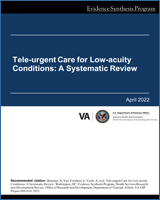This publication is in the public domain and is therefore without copyright. All text from this work may be reprinted freely. Use of these materials should be acknowledged.
NCBI Bookshelf. A service of the National Library of Medicine, National Institutes of Health.
Boucher N, Van Voorhees E, Vashi A, et al. Tele-urgent Care for Low-acuity Conditions: A Systematic Review. Washington (DC): Department of Veterans Affairs (US); 2022 Apr.
A 45-year-old female Veteran with mild intermittent asthma, obesity, and military sexual trauma (MST) contacts her primary care provider with a complaint of wheezing and cough over the last 2-3 days. She calls her VA primary care clinic on a Thursday and speaks with her PACT nurse.
On further questioning, the patient notes that she does not have a fever or COVID exposure. She has a couple of old inhalers at home that she has tried to use which helped “a little.” She is mildly short of breath when going upstairs or walking her dog, but able to do everything around the house that she needs to do. According to the nurse triage tool, the patient needs to be evaluated within 48 hours. The PACT nurse checks with the scheduler and notes that the primary care provider’s schedule is booked for the day and they do not have any in-person gap visit slots within 48 hours. The patient is counseled on where in her community she can seek in-person urgent care, if needed. Understandably, the patient does not want to make the 90-minute drive to the VA ER as her 7-year-old daughter is home due to a teacher workday; however, she is concerned that it will get worse over the weekend and she won’t know what to do.
The PACT RN confers with a provider in the clinic and together they decide to schedule the patient for a tele-urgent care visit via the VA video-connect platform. A video visit is chosen because of the acuity level of the patient’s symptoms and the need to minimize exposure to other patients in case she has an infectious illness (eg, COVID). Two hours later, the patient completes a video-based visit with a VA provider. The provider is able to watch the patient’s breathing and speech pattern during the video visit and determines that she is not in respiratory distress. The patient is able to show the provider her old inhalers and demonstrate her technique. The provider is able to instruct her on which inhaler to use when and demonstrate correct inhaler use techniques.
Over the virtual platform, patient receives instructions on self-care and guidance on when and where she should seek higher-level care or follow up with her primary care provider. The patient does not need to present to the ER over the weekend and slowly improves from her asthma flare. She follows up with her primary care provider the following month for routine management of her chronic condition.
- WHAT IS TELE-URGENT CARE: A CASE VIGNETTE - Tele-urgent Care for Low-acuity Cond...WHAT IS TELE-URGENT CARE: A CASE VIGNETTE - Tele-urgent Care for Low-acuity Conditions: A Systematic Review
Your browsing activity is empty.
Activity recording is turned off.
See more...
